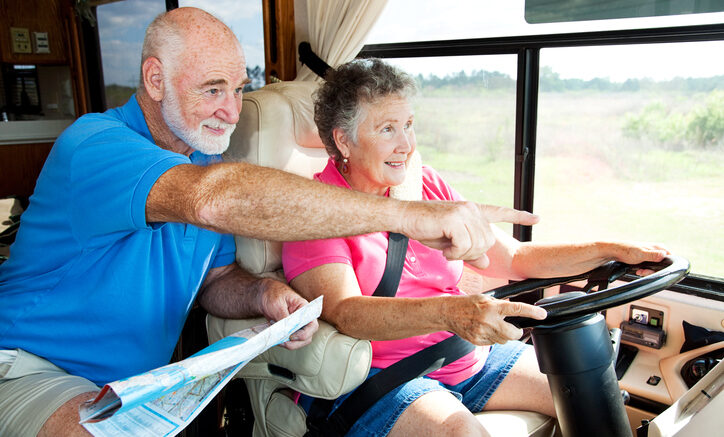Are you a new owner of a recreational vehicle who wants to stay safe on the road? It’s best to follow these 10 driving tips for RVs, campers, and motorhomes.
Are you used to driving the average four-door sedan? If so, you’re in for a few surprises when you get behind the wheel of a 30,000+ pound RV. Driving recreational vehicles is very different than driving your car, SUV, or truck. These vehicles are so large and heavy that you have to develop an addition skill set to make turns, stop, park, and more. How have you prepared for the responsibility of piloting these gigantic vehicles? To help you stay safe on the road, we’ve curated these 10 RV driving tips.
Here are 10 safety tips for driving your RV, camper, or motorhome:
- Adjust Your Mirrors and Seats Adjusting the mirrors and seats is the first thing you should do before starting out in your RV. Adjust each so that you are comfortable and can clearly see in all possible directions. Knowing what is in front and behind your vehicle are among the most important things you need to do when you’re on the road.
- Become Familiar with the Size of Your RV Driving an RV is not like driving in your everyday vehicle. You need to know just how high your vehicle is, especially when approaching a bridge. (Most bridges are 13-14 feet high.) You can literally shear the roof off your motorhome if you try to drive beneath a bridge that’s too low for your vehicle. For safer driving, you also should know the width of your RV. Vehicles wider than 8.5 feet require an oversized load permit.
- Practice Proper Parking We can’t stress this enough, RV owners. Parking an RV, camper, or motorhome is an art and a science. Most RV parking is done in reverse, which creates plenty of blind spots. If you’re motorhome has a trailer attached to a truck, it can get rather tricky. This is why we recommend you practice parking your vehicle as much as possible. This helps you familiarize yourself with your new recreational vehicle and its challenges.
- Learn to Drive Uphill and Downhill Taking your RV on vacation could mean driving on mountainous roads. Remember, you’re driving a rather heavy load that can make your engine overheat if you don’t know what you’re doing. When driving uphill, you have to go under your vehicle’s maximum horsepower. Learning how to downshift is key to operating your RV within this range.Driving downhill is another skill you must learn. Here, you want to use your brakes as little as possible. Try dropping your vehicle into its lowest gear before your tires hit the downgrade. Go slowly and use your brakes sparingly. If your rig accelerates more than five miles per hour in five seconds, use the next lowest gear. To keep brakes cool, stay three seconds for each second you use them. (Note: It’s better to rely upon the engine brake and gears when driving downhill.)
- Maintain a Safe Distance Because of their weight and size, your RV takes longer than your car to come to a complete stop. To get a feel for this, try testing your stopping times in empty parking lots before you take your motorhome on the highway. To make sure you have enough room to stop in an emergency, keep one second for each 10 feet of RV length behind the vehicle in front of you.
- Check Tire Pressure Much of your safety and the safety of others depends upon your tires. If you’re taking a trip that lasts a couple days, check your tire pressure. If you’re driving for multiple days, check your tires before each leg of the trip.
- Gas Tank Check Do you know which side of your vehicle your gas tank is located? If you don’t, it’s best to become familiar with its location before you head out on the road. If you pull into a gas station and find yourself on the wrong side of the pump, you’ll likely struggle to get it turned around. Knowing where your gas tank is located saves you a lot of time and spares plenty of frustration.
- Secure Large Objects It’s not uncommon to take things with you on a trip. Large, heavy items can be placed on top of or behind the RV, as well as inside of it. Make sure to secure these items. One sharp turn can cause these things to fall and injure you, your passengers, or other drivers.
- Plan Your Route When you’re taking a trip, you should know the best way to get to your destination. Planning your route forewarns you about low-hanging bridges, proper parking, and more. Do you research on the Internet and program your route into a GPS system so you’ll be prepared for anything you could encounter on the road.
- Go to RV Driving School If you’re new to the RV world, you could benefit from RV driver training. Many states have RV driving schools that teach you how to drive and park your motorhome and much more. One of these comprehensive courses is a great way to stay safe on the road and protect the investment you made in your recreational vehicle. Do some research online to find the best RV driving school near you.
Want Satellite TV for Your RV?
Once you get familiar with how your RV handles, you’ll likely take plenty of trips. While you’re away, you could miss your favorite news, sports, and entertainment. This is why you need satellite TV programming. Signal Connect is a DIRECTV and DISH authorized dealer. We specialize in delivering satellite solutions TV to RVs and campers. Our experts can match you with the best satellite TV viewing package and equipment. Just give us a call at 888-233-7563.





